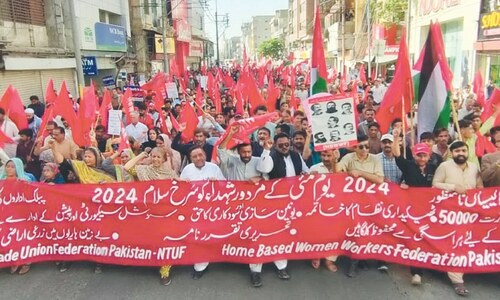
QUOTING Pakistan Economic Survey, the Pakistan Agriculture Scientist Association has come up with some statistical realities about agriculture stagnation in Punjab.
According to these figures, during the first four years of the incumbent government (2007-2010), the province either kept losing acreage of all major crops, or witnessed productivity (per acre yield) going down.
Holding the Punjab government responsible, the association maintains that precisely because of its failure, food insecurity has increased in the country. The World Bank has put the percentage of ‘malnourished and food insecure’ Pakistanis at a whooping 51 per cent. This compares with 22 per cent five years ago, and shows an increase of 131 per cent.
According to the association’s figures, the area under wheat in Punjab increased by 0.20 per cent during these four years, but overall productivity declined by 9.7 per cent. The per acre yield fell by 9.90 per cent. On the other hand, when compared with Punjab, area under cultivation for wheat in Sindh expanded by 4.75 per cent. Its production increased by 13 per cent and the per acre yield by 8.25 per cent.
Meanwhile, area under cultivation of rice in Punjab grew by 4.07 per cent, with production increasing by 2.31 per cent. But its per acre yield declined by 1.76 per cent. In Sindh, the area under cultivation of rice went up by 9.96 per cent, while production increased by 12.84 per cent and per acre yield by 2.88 per cent.
For cotton, the area under cultivation in Punjab reduced by 2.34 per cent. Production went down by 11.81 per cent and the per acre yield declined by 9.47 per cent. On the other hand, in Sindh, the area under cultivation for cotton increased by 1.53 per cent, while production went up by 28.57 per cent and the per acre yield by 27.04 per cent.
Sugarcane performed relatively better, mainly because of better seeds. While the area under cultivation for the crop in Punjab reduced by 0.94 per cent, its production increased by 2.48 per cent. The per acre yield for the crop also increased by 3.42 per cent. However, Sindh remained better off, as the area under the crop there increased by 14.49 per cent, and production by 12.98 per cent.
Meanwhile, for maize, area in Punjab declined by 0.94 per cent, but productivity and per acre yield increased by 2.48 per cent and 2.48 per cent respectively. On the other hand, Sindh saw a reduction in the area for the crop by 6.66 per cent, but its productivity still increased by 11.11 per cent and per acre yield went up by 17.77 per cent.
Meanwhile, the area under other crops in Punjab, like gram, lentil, mung, mash, canola and sunflower, declined by 0.85, 55.60, 17.12, 29.46, 45.79 and 16.67 per cent respectively.
Due to declining performance of the sector, as well as increasing cost of inputs and resulting inflation, the cost of food per head in the province has gone beyond Rs3,000 per month. For an average-sized family (5.5 persons), every household needs Rs16,500 per month only for ensuring the provision of basic food. How can people be expected to spend Rs16,500 only on food every month, given that the minimum monthly wage is only Rs8,000? The people would also be neglecting education, health, and social obligations. That is where the province has landed in the last few years, the association maintained.
These five years also saw two international spikes in food prices, which pushed over 900 million people worldwide down the poverty line. It was hard to insulate Pakistan from the consequences. But this should not have been an excuse for the failure to form an effective farming policy. The present Punjab government is certainly guilty on this account.
With changing international innovations (technological and awareness), agriculture has become an almost exact science and industry, which now needs equally precise policies and production standards. It applies to the entire agriculture sector, including all its sub-sectors, like livestock and horticulture.—Ahmad Fraz Khan











































